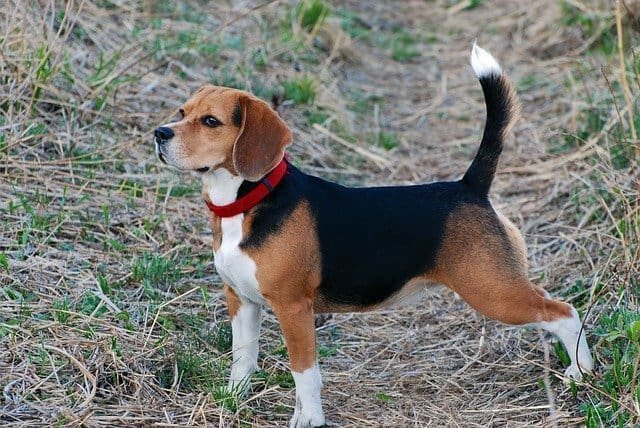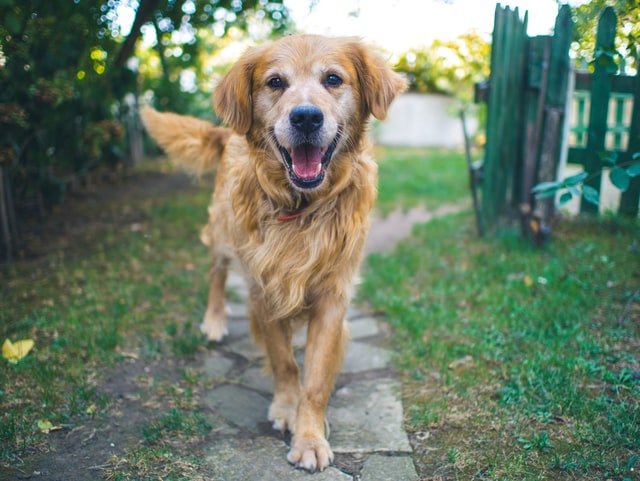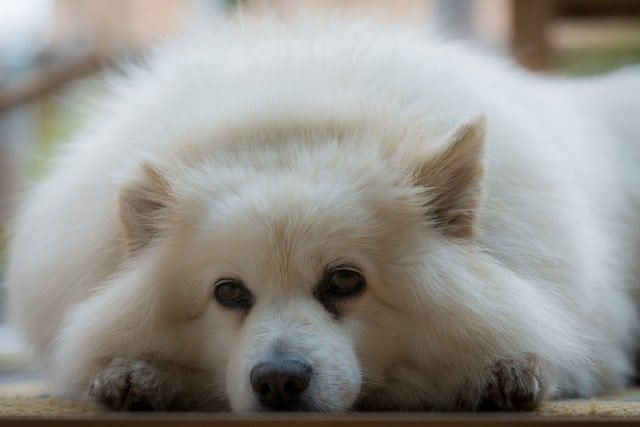A dog’s tail is one of his most prominent traits and features. You’re probably pretty familiar with your own dog’s tail wagging.
But is a wagging tail always a sign that your dog is happy? How can you tell what a dog is feeling by his tail swish?
In this article, we’ll cover everything you need to know about what your dog’s wagging tail means.
Table of Contents
Dog wagging tail meanings – is he happy?
All dog owners have seen their dogs’ tails wag. Your dog probably wags his tail a lot during the day.
When you see your dog wagging his tail, you might be wondering what that means. When a dog is wagging his tail, the immediate assumption is that it’s a sign the dog is happy.
It’s true that wagging his tail is one way for your dog to communicate with you that he’s feeling happy or excited about something. But there are several other reasons why a dog’s tail might be wagging.
This can make it a little confusing for us as humans. Since dogs can’t talk to us, you have to rely on your dog’s body language to determine what he’s thinking and feeling.
So it might be weird that a dog’s tail can wag for so many reasons! The good news is that you can usually use context clues to tell why your dog’s is wagging his tail.
Before we get into it, check out these related weird dog behavior articles:
- Why Is My Dog Sniffing Me More Than Usual?
- Why Is My Dog Barking at Nothing?
- Why Do Dogs Chase Their Tails?
Happiness and excitement
Of course, the most well-known reason why dogs wag their tails is because they’re happy.
Dogs aren’t able to use words to communicate feelings the way that we can. Instead, they have to use body language to show what they’re thinking and feeling.
Your dog’s tail is one of the most expressive parts of his body. You can usually tell what he’s feeling based on what his tail is doing.
If your dog’s tail is held level or slightly upright, then that usually indicates that your dog is feeling happy. The speed at which he’s wagging his tail will also tell you how happy his is. Usually, the faster the wag, the happier or more excited your dog is feeling.
As long as it’s held in this neutral or slightly upright position, that shows that your dog is pretty happy.
Nervousness
While a wagging tail can demonstrate to others that your dog is happy, it might also be a sign that he’s feeling nervous.
When dogs feel uncertain or insecure about something, they’ll use their tail to try and communicate this.
For example, your dog might be nervous about someone coming to your door. He may not know what to expect from whoever is on the other side! To show that he’s not feeling entirely comfortable with the situation, he might start wagging his tail.
In these cases, your dog will probably stand with his tail raised high and only wag it slightly. You may also find that his ears are standing upright and that the rest of his body is slightly stiff.

Submission
Submission in dogs can be a major behavioral issue.
There’s a difference between a dog that’s ready to listen to and follow commands, and a dog that’s feeling submissive.
When dogs are feeling submissive, that’s usually because they’re in a situation that’s making them uncomfortable. Acting submissive may be the only way they know to handle this situation.
There are usually several indicators that will show that your dog is feeling submissive. One is his tail.
A submissive dog might hold his tail a little bit lower than its natural position. It might also wag very slightly. If your dog is holding his tail in between his legs, that’s a clear sign that he’s feeling frightened.
For a little more information on submissiveness in dogs, make sure you check out these articles:
Feeling threatened
When a dog feels threatened, it’s important to treat this dog very carefully. A threatened dog can often turn into a reactive or aggressive dog.
If your dog is holding his tail high or arching over his back, he’s probably feeling pretty nervous about something. If your dog is holding his tail vertically, and it’s wagging very quickly, that could indicate aggression.
Be very careful around a dog that is in this state. Make sure to act calmly, and don’t get too close to the dog until he’s settled down.
Dogs that are feeling reactive or aggressive might bite and seriously injure someone.
If you’re looking for some more help with dog aggression, these related articles will be able to help you:
- My Dog Gets Aggressive When Tired—What Can I Do?
- 6 Signs of an Aggressive Puppy and How to Stop It
- How to Stop Your Dog from Guarding Food
Related topic: For dog training in general I highly recommend you get a program that walks you through step by step, such as Braintrainingfordogs. Certified dog trainer Adrienne Farricelli teaches you to train your dog to be the best dog he can by be using mental stimulation! Check out Dogpackr’s review to see if this is a fit for you!

Stress and anxiety
Another reason why your dog might start wagging his tail is because he’s feeling stressed out or anxious about something.
There are lots of things that can cause stress or anxiety in dogs. And every dog is different, so their triggers will be different too.
If your dog is feeling anxious about something, then one of the ways he might demonstrate that is through his tail. A dog that’s feeling stressed out might hold his tail fairly low and wag it very slowly.
If you’re dealing with a stressed out or anxious dog, here are a few articles that might be able to help you:
- 9 Signs Your Dog Is Stressed
- How to Calm a Stressed Dog Naturally—11 Tips
- 9 Signs and Symptoms for Separation Anxiety in Dogs
Is a wagging tail a sign of a happy dog?
Now that we’ve gone through all the reasons why a dog’s tail might start wagging, you’re probably wondering when, exactly, it’s the sign of a happy dog.
Knowing how to identify the difference between a dog that’s wagging his tail out of joy or fear will help you determine how you should be interacting with that dog.
Here’s a little more information on happy dogs and their tails.

It depends on the kind of wag
Of course, the best way to tell if a dog is wagging his tail out of happiness is to identify the kind of wag his tail is doing.
Depending on the position of the tail and the wagging speed, you should usually be able to tell what a dog is feeling.
As we already talked about, a dog that’s happy will hold his tail neutrally or slightly upright.
If the dog is feeling stressed or fearful, it will be held much lower down, possibly even between his legs.
And a dog that’s in a reactive state will probably be holding his tail vertically.
So if you see a dog whose tail is wagging, don’t automatically assume that the dog is happy. Make sure to pay attention to the way he’s wagging his tail.
If his tail is signalling that he’s happy, it’s safe to approach the dog.
On the topic of happy dogs, here are a few related articles for keeping your dog happy:
Generally, a tail wagging dog is more excited than happy
If you want to try and determine what a dog is feeling, it’s also important to understand that wagging usually tells you how excited a dog is.
Happy dogs will certainly wag their tails. But a happy tail wag will usually be pretty minimal. Instead of the speed of the wag, the way the dog is holding his tail will tell you if he’s happy.
But the speed at which your dog is wagging his tail will tell you a lot about his mood too! Generally, the faster a dog’s tail is wagging, the more excited he is.
Just understand that an excited dog isn’t necessarily a happy dog!
Dogs can get excited due to stress or fear. So make sure you’re paying attention to how your dog is holding his tail as well as the speed of the wag.
For a little more information on overexcitement in dogs, these articles will help:
- 5 Tips to Calm an Overexcited Puppy Quickly
- Overexcited Dog with Visitors—Here’s What to Do!
- How to Deal with an Overexcited Dog on a Walk
Do dogs wag their tails on purpose?
Dogs will wag their tails to tell us—and other dogs—what they’re feeling. But you might be wondering whether or not your dog wags his tail on purpose.
Your dog does have control over the muscles in his tail. Lots of dogs use their tails for balance, and it’s important to be able to control that balance.
But when it comes to showing things like emotions through their tails, the wag is probably instinctive rather than purposeful.
It’s probably a lot like the way we make facial expressions during conversation! We might smile or frown or laugh. Even though these tell other people how we’re feeling and we’re able to do them on purpose, these expressions are mostly just reactions to other stimuli.
Dog tail wagging FAQ
Have more questions about your dog’s tail? I’ve got some answers for you!
Why does my dog wag his tail when he sees me?
After coming home from a long day at work, you probably walk into your home and see your dog waiting for you at the door.
And, most likely, your dog’s tail is wagging!
In fact, your dog’s tail might begin to wag whenever he sees you. So why exactly is that?
Well, the answer is simple and pretty cute too. Your dog’s tail is most likely wagging because he’s excited and happy to see you!
You’re an important member of your dog’s pack. You feed him, house him, and, most importantly, you give him lots of love and affection. No wonder he’s so glad to see you!
Dog wagging tail while lying down, what does that mean?
It might look pretty weird when your dog tries to wag his tail when he’s lying down. So why exactly is your dog doing this?
Dogs will wag their tails in a variety of situations. Fear, happiness, and stress can all make a dog start wagging his tail.
But dogs will wag their tails in a variety of positions too! Your dog will wag his tail when he’s standing up, as well as when he’s sitting or lying down.
Your dog might be happy to see you, or he’s hearing something that’s stressing him out. You can usually use context clues to determine what’s making his tail wag. What pose he’s doing it in, though? That simply doesn’t matter that much.
Why do dogs wag their tails when they are in trouble?
All dogs get into trouble once in a while. Dogs are a lot like human kids that way!
What’s confusing is that your dog’s tail might wag when he’s in trouble. So why is that?
Your dog might know that he did something wrong and he’s wagging his tail because he’s a little nervous.
Your reaction to your dog might also make him wag his tail!
Remember, happiness and excitement aren’t the only reasons why dogs wag their tails. Stress or anxiety can make his tail wag too!
Do dogs wag their tails when they attack?
If you are dealing with an aggressive or reactive dog, you might have noticed that his tail wags before he jumps and attacks whatever’s triggering the feeling.
When dogs are feeling reactive or aggressive, you might notice that their tails wag slowly. Dogs will understand this, but many humans see that wag as friendliness.
That’s why it’s so important to know the different types of ways a dog’s tail will wag. Knowing how to tell when a dog might be feeling aggressive will help you and the dog stay out of danger.
Conclusion
Dogs use their tails to express a lot of different feelings—more than you might have expected! Knowing how to tell why a dog’s tail might be wagging will help you react appropriately to any given dog and situation. So make sure that you know what your dog’s tail means!
*Disclosure: This post may contain affiliate links, meaning, I get a commission if you decide to make a purchase through one of my links, at no cost to you.






